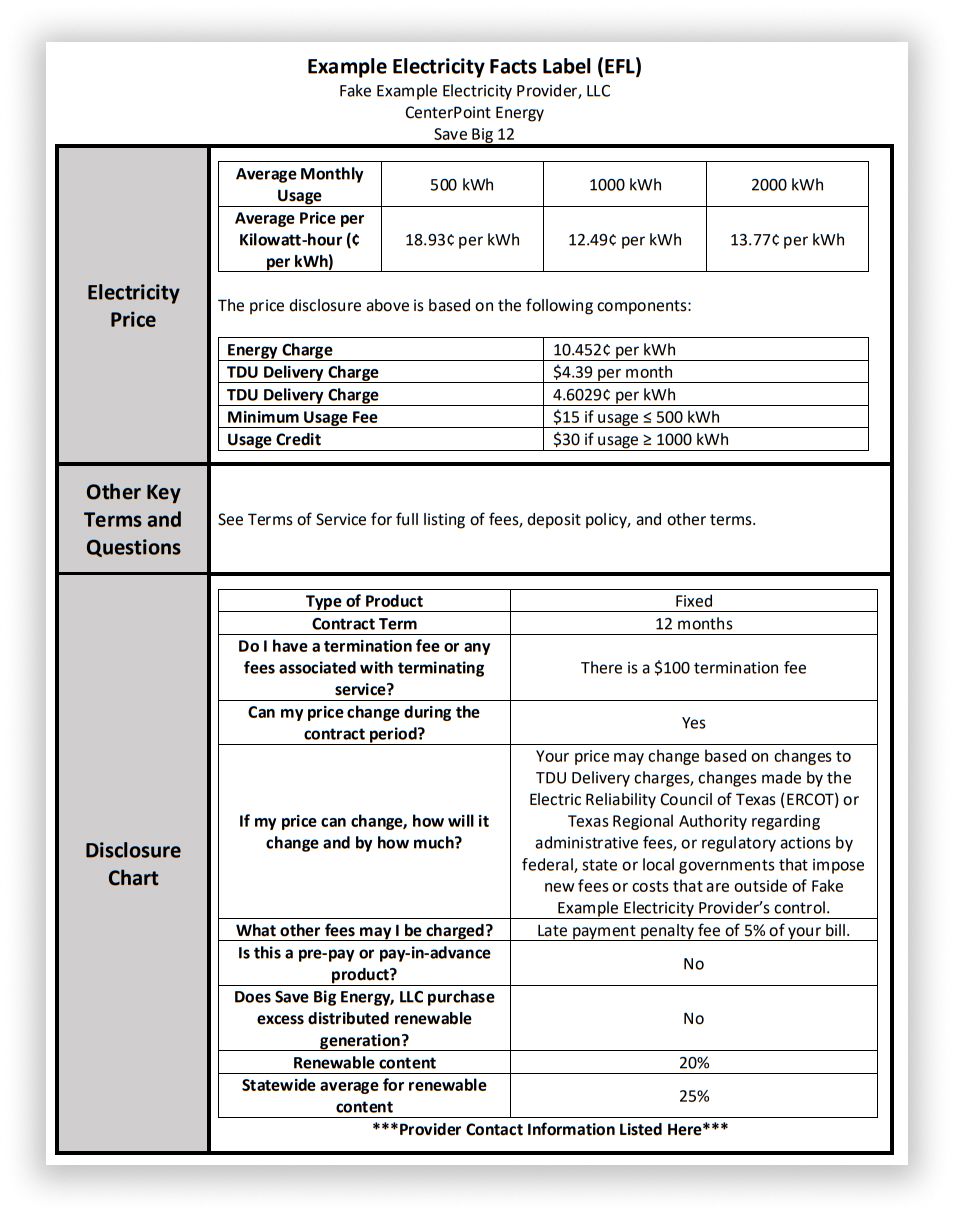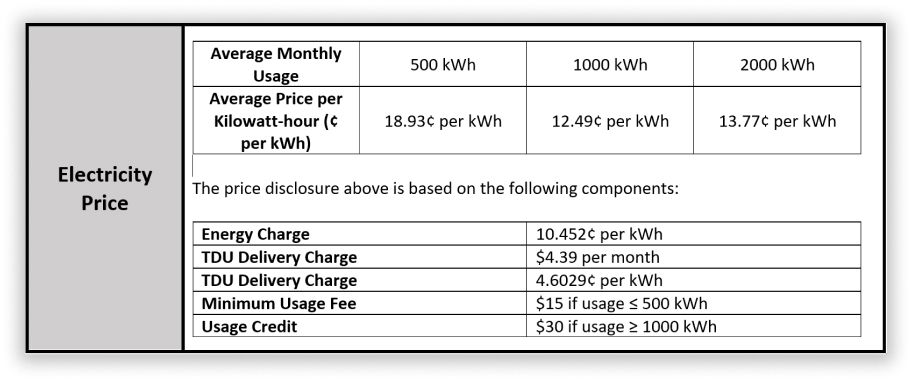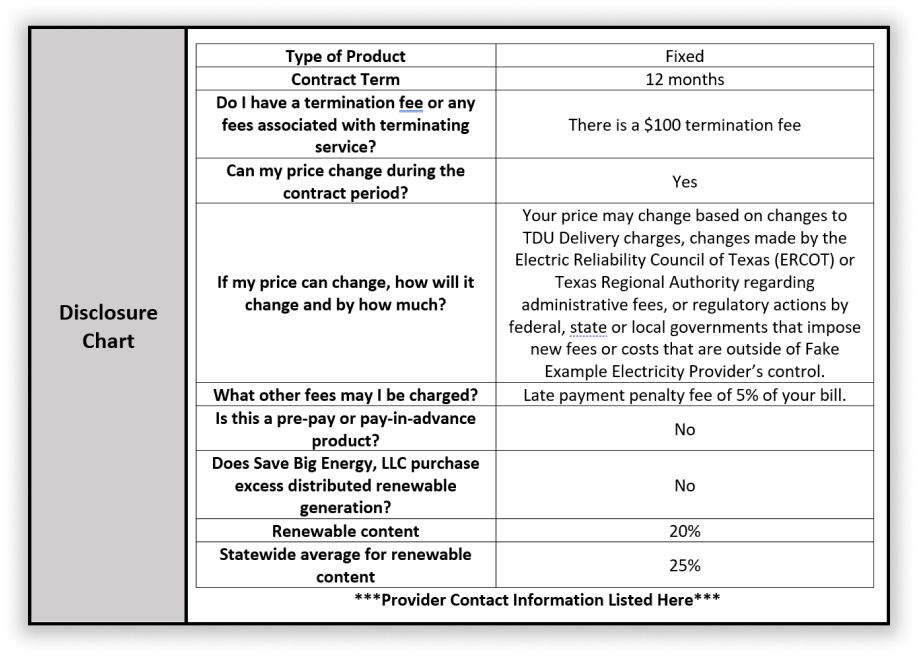The browser you are using is not supported. Please consider using a modern browser.

How To Read An Electricity Facts Label (EFL)
Table of Contents

Every Texas electricity plan has an Electricity Facts Label. This important document provides pretty much everything you need to know about an electricity plan, so you can make an informed decision on whether or not you want to enroll.
Unfortunately, even though EFLs are meant to be straightforward, the various terms and numbers can be confusing. We’re here to clear that up, so you can understand how to read an Electricity Facts Label and find the perfect electricity plan for you.
Key Takeaways
- The Electricity Facts Label is a document that gives you a breakdown of charges and terms for an electricity plan in Texas.
- Texas electricity companies are required to disclose fees and credits in the Electricity Facts Label.
- You can use the EFL to manually calculate how much a plan will cost at your usage level.
- To save time and find the cheapest plan for your usage, you can use Tiler, ElectricityRates.com’s AI-powered rate assistant. Enter your ZIP Code above to get started.
What Is An Electricity Facts Label?
The Electricity Facts Label is a standardized document that provides an overview of a Texas electricity plan, including the charges, fees and credits associated with the plan. The Texas Public Utilities Commission (PUCT) requires Texas electricity companies to include an EFL with every plan.
The EFL consists of three sections:
- The Electricity Price Section
- The Other Key Terms and Questions Section
- The Disclosure Chart Section
Example EFL

Electricity Price Section

The Electricity Price section gives you the average price per kilowatt-hour (aka the effective electricity rate) at three different usage levels. It also provides a breakdown of the charges, fees and credits for the plan. This information shows you how your electricity usage each month will impact your effective electricity rate and total electric bill.
Below we have a breakdown of some of the most common types of charges, fees and credits you will see on an EFL.
Energy Charges
The energy charge, or energy rate, is the cost of the electricity you use by the kilowatt-hour (kWh). This rate does not include any fees, bill credits, or other discounts that may be included with the plan.
TDU Delivery Charges
TDU charges go to your electric utility provider to support the delivery of your electricity. It consists of two charges. One is a base charge, which is a fixed price paid each month no matter how much electricity you use. The other is a rate charge, which is charged by the kilowatt-hour.
Neither you nor your electricity provider has any control over these charges. They are the same for everyone in the service area of that utility company.
Minimum Usage Fee
Some providers charge a minimum usage fee if you don’t use a certain amount of electricity within a given month.
For example, say you have an electricity plan that has a minimum usage fee of $15 if you don’t hit over 500 kWh usage within a month. If you only use 450 kWh, your provider will charge you an extra $15 on your next bill, increasing your total bill and effective electricity rate on that plan.
Usage Credits
A usage credit is applied to your total bill when you hit a certain level of electricity usage in a month. They lower your total electricity bill, and therefore, your effective electricity rate.
Most usage credits come into effect at 1,000 kWh. However, some providers apply usage credits at 1,500 kWh or 2,000 kWh. For some electricity plans, usage credits are only applied if you are within a range of electricity usage (for example, between 1,000 kWh and 1,500 kWh).
Other Key Terms and Questions Section

The Other Key Terms and Questions section has any specific details that the electricity company wants you to know about the plan. Most of the time, this section will point you towards the Terms of Service for the electricity plan.
Disclosure Chart Section

The Disclosure Chart section on the EFL gives general information about the electricity plan. Here are some of the most important aspects of this section.
Type of Product
The type of product will tell you whether the plan has a fixed rate, a variable rate or if it is an indexed plan. ElectricityRates.com carries fixed-rate plans because they almost always save you more than variable-rate plans. They also ensure that you don’t have surprise rate hikes that end up costing you more.
Indexed plans have rates that are lower at certain times (usually at night) but higher at others (usually during the day). These plans are only beneficial if you use most of your electricity within the lower-rate time frame. Otherwise, they will likely cost you more than a regular fixed-rate plan.
Contract Term
This is the length of the plan and tells you how long the terms of your electricity plan will last.
If you’re on a fixed-rate plan, this means most of the charges, fees and credits from the Electricity Price section will be locked in for the duration of the plan. The only charges that can change are usually for those that are outside the provider’s control, like TDU Delivery Charges.
Do I Have A Termination Fee?
Many fixed-rate electricity plans have cancellation fees. If you cancel your plan before the end of the contract, the provider will charge you this dollar amount. Sometimes, cancellation/termination fees will depend on the amount of time you have left in your contract.
Renewable Content
This section tells you what percentage of the plan is sourced from renewable energy. Many plans in Texas offer 100% renewable energy. These plans ensure that no matter how much electricity you use, an equal amount of renewable energy enters the grid.
How To Compare Plans With Ease
If you want to compare electricity rates without having to worry about trudging through EFL documents and calculating how much each plan costs at your usage, you should check out Tiler, ElectricityRates.com’s new AI-powered rate assistant.
Tiler takes the time-consuming process of calculating how much an electricity plan will cost and does it for you. Enter your electricity usage, and Tiler will find the plan that costs you the least. There’s even a transparent graph that estimates how much the plan should cost you throughout the year.
So give it a shot! All you need to do is enter your ZIP Code above and select the option to use the Tiler rate assistant.
Electricity Facts Label (EFL) FAQs
-
An Electricity Facts Label gives you an overview of the electricity plan, so you can determine whether or not it’s the right plan for you at your level of electricity consumption.
-
The Average Price per kWh is the effective electricity rate for a plan at a specific level of usage; it’s based on all the charges, fees and credits that go into your total bill. An energy charge is how much you pay for the electricity you use; it’s only one of the many different charges, fees and credits that contribute towards your total electricity bill.
-
A usage credit lowers your total electricity bill by a specific dollar amount when you hit a certain level of electricity consumption in a month (often 1,000 kWh). Because you pay less even though you use more electricity, usage credits can lower your effective electricity rate. This is part of the reason why it’s important to consider how much electricity you use when comparing plans.
-
The average price per kilowatt-hour for any Texas electricity plan depends on how much electricity you use. To find it, you can use the following formula:
Average Price per Kilowatt-Hour (kWh) = Total Bill ÷ monthly kWh consumed